My friend and fellow pilot, Dave Lehr, suggested that we fly to Gariep (from Cape Town), but instead of taking the same route back we should rather take an extra few days and follow the Orange River from Gariep to Alexander Bay, and then route coastwise back to Cape Town covering the entire west coast of SA.
Given that I am a new pilot (qualified in Feb 2011 and at the date of departure had 70 hours total in my logbook) I was fairly nervous about Dave’s suggestion. The longest I had ever flown was 2.5 hours on my cross country from Fisantekraal to Saldahna and back. Dave and his cousin Jonathan Mylrea have done many gyro safaris and Jonathan had done the route planning for this proposed trip as well. His plan called for up to 7 hours of flying in a single day and to me this sounded like a daunting prospect. (At 6ft7in and 110kg I’m not the smallest person and my gyro is more like economy class than business). Both Dave and Jonathan assured me that this was no problem. Both insisted that a long trip is just a collection of smaller ones. The planning called for total self-sufficiency, no ground support. We needed to carry all our spare fuel, tool kits, clothing, medical kits, water etc. and would be landing to empty our jerry cans into the main tanks giving us a chance to stretch and answer the calls of nature.
The original plan called for us to leave on Friday (20 May 2011) but Cape Town was solidly fogged in for most of the week and the decision was taken to leave on Thursday at around midday to ensure we could actually get out.
Not having done a gyro trip before I did a few test packs in the day’s preceding the departure. I packed what I thought to be the acceptable minimum into my gyro (most of my kit was camera gear, which, with the benefit of hindsight, I could have done without a fair portion). The day before departure I loaded up my gyro and did a few circuits to get a feel for the loading and weight distribution. Everything seemed ok so I flew to Goedverwacht and left my gyro hangered together with Dave and Jonathan. The Goedverwacht site has a small grass strip and I had not done too many off tar landings at this point. I remember being nervous at the thought of landing there with a loaded gyro. That night it rained plenty and I had my doubts as to whether or not we would be leaving the next day.

Over into Bainskloof Pass with just a small bit of turbulence.
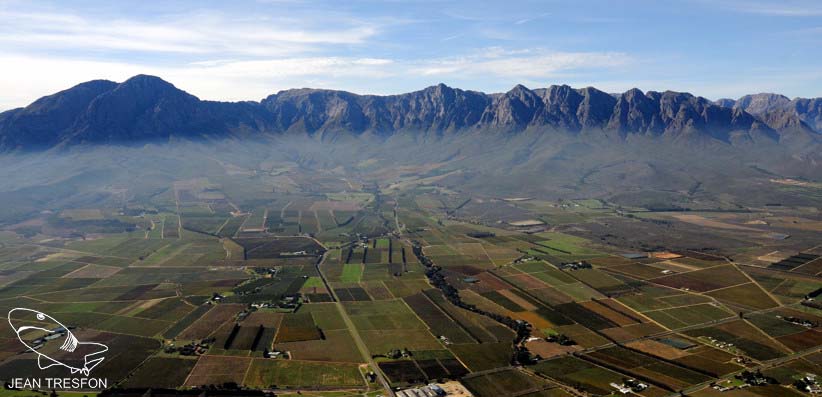
The Breede River Valley as you exit Bainskloof Pass.

Following the Breede River south to Worcester.

Refueling at Worcester Airstrip.
Thursday dawned with blue skies, no wind and absolutely perfect flying conditions. The take off was uneventful (except for Jonathan who heard a slight bang as he lifted off). We routed for Bainskloof Pass and climbed to 4000ft as we got out of the TMA. This was only my second time flying over big mountains and even with no wind I was apprehensive. The mountains stretched out on either side as we approached, appearing to me like a row of shark teeth just waiting to bite me! The view was breathtaking and I headed into the pass with just the slightest turbulence. On the radio we could hear Len Klopper’s gaggle of gyros about 20 minutes behind us as they took off at Morningstar. We routed along the Breede River and soon afterwards landed at Worcester airfield to top off the main tanks. Jonathan found a nick on one of his propeller blades which must have been caused by a stone on take off at Goedverwacht. After refueling out came that greatest of South African inventions, the Pratley’s Putty. With expert attention the putty was mixed, applied to the prop, shaped and molded, allowed to dry, sanded to a fine finish and voila, the prop was as good as new. While we were busy with the repair an armada of gyros passed overhead as Len’s group plus a few others routed for the Hex River Valley and De Doorns.
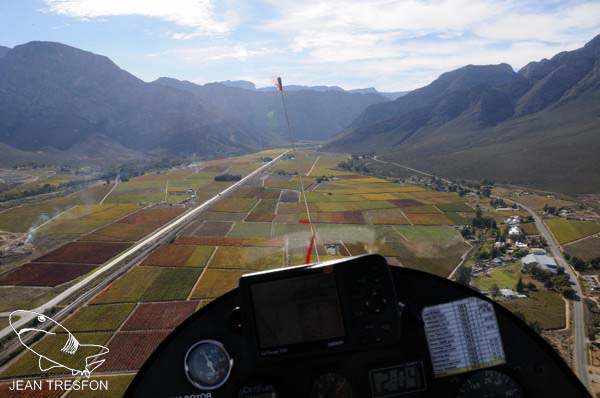
Routing into De Doorns and the Hex River Valley.
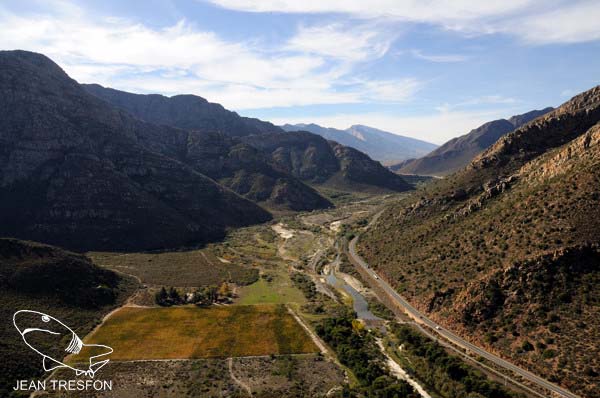
A small pass into the Hex River Valley.
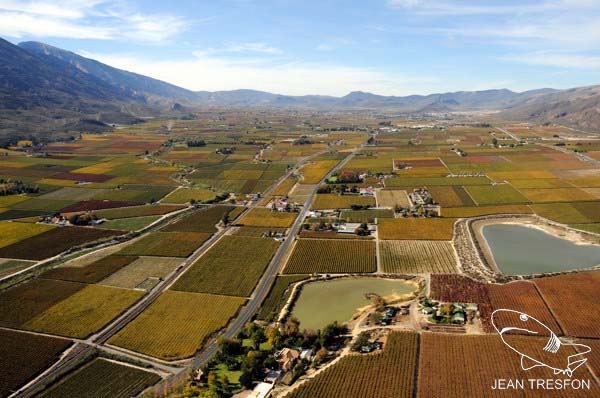
The Hex River Valley is stunning with a myriad of colours like a giant patchwork quilt.
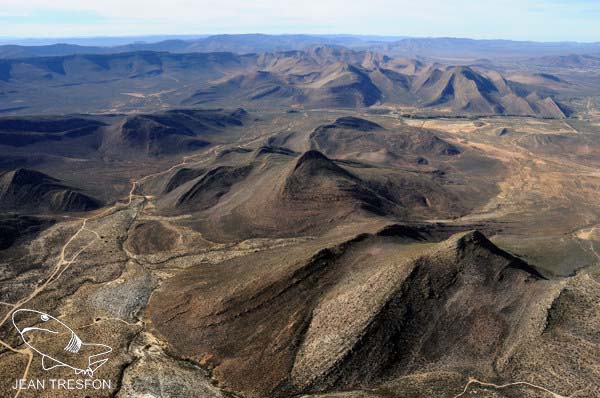
The terrain is suddenly more hostile.
Eventually we set off again and the scenery was just spectacular. The Hex River Valley was a giant patchwork quilt of exquisitely coloured farm fields and we followed the river through towards De Doorns. The mountains marked the end of the valley and as we climbed over the escarpment the scenery changed dramatically to a dry, rocky terrain. I also noticed my engine revving higher than it should and made a mental note to remember that my prop was set too fine for altitude and I should be careful not to over speed the engine.

Matjiesfontein
Our next destination was to land at Matjiesfontein to refuel from the jerry cans, but arriving overhead it was clear that the runway was unusable due to extensive flooding and water damage. (Another lesson, always have enough fuel to make it to an alternate landing place). We pushed on to Laingsburg where Len’s group had just landed. They warned us about rocks on the runway??? The kids from the local informal settlement used the runway as a soccer pitch and every 50m or so there were a pair of large rocks to mark the goal posts! Jonathan landed just ahead of me and radioed to warn me that there were more rocks ahead. I came in past what I thought was the last set of rocks and just at the end of my float as I was about to touch down another pair of large rocks appeared…! A few choice expletives escaped as I applied power, made it over the rocks and plonked down for a messy landing. (I remembered my instructor’s warning about always doing a full runway inspection and added this to my store of school fees being paid).

Refueling after landing at Laingsburg and meeting up with Len's gaggle.
A jovial and social refueling session followed as there were now about 10 or more gyro on the ground, plus Len’s support vehicle. I was very glad for the stop, my rear end had long since ceased to have any blood flow and my first few steps out of the gyro must have been fairly comical to witness. I was admiring the creature comforts of Len’s M24 and the fact that his one had its own stewardess (sorry Christine!). The fuelling over, several of the gyros lined up in a row to conduct pre-flight checks and go. The aeries were fairly close together with props spinning up to 3000rpm as mag checks were done and one had to be careful not to connect with another gyro. Our group decided to head off while the others were still in the process of packing and time was now starting to become an issue as sunset approached. I was nervous of the rocks on the runway and pulled back too hard as I lifted off, feeling the tail wheel bump the ground for a messy take off. And then it was Beaufort West or bust as we increased our ground speed slightly to make up time.

Following the N1 towards Beaufort West.
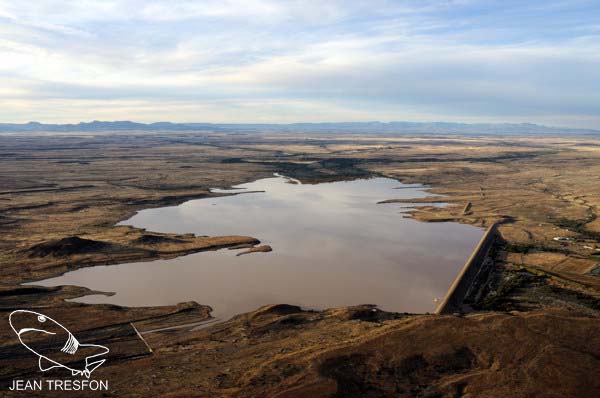
Leeugamka Dam.

The sun starts to dip towards the horizon, not much light left.

Dave lands just as the sun sets.
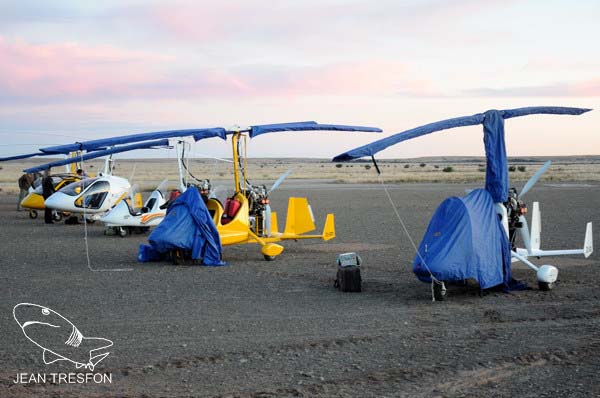
Putting the gyro's to bed.
Len’s group caught up quickly, and a mass invasion of the Karoo Gateway Lodge followed as all the gyros landed safely just as the sun was dipping its head below the horizon. A few drinks, a stunning meal and then I tottered off to bed after my first full day of flying. The following morning we fuelled both the gyros and ourselves and by late morning it was wheels up.
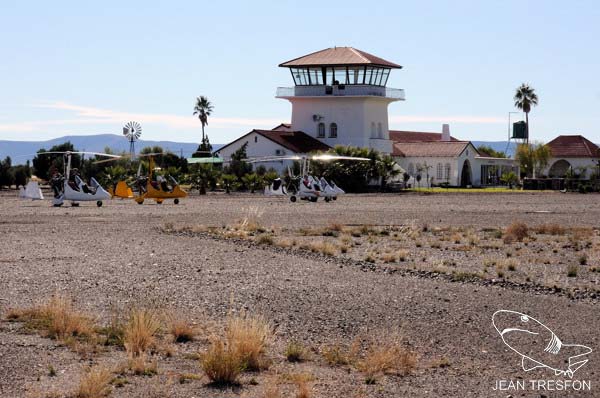
Mid morning departure from Beaufort West.
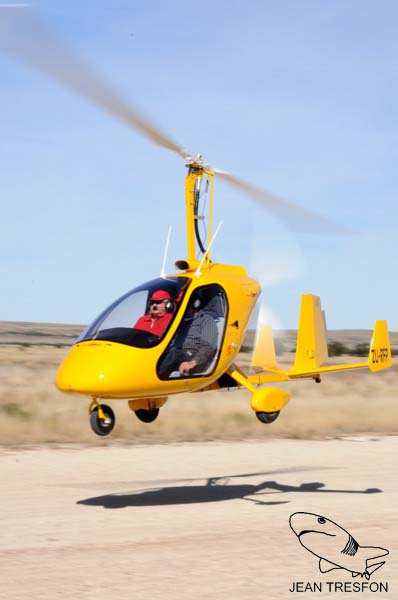
Nick takes off.

Following the N1 north.

The terrain changes yet again.

Paul routes low level along the koppies.
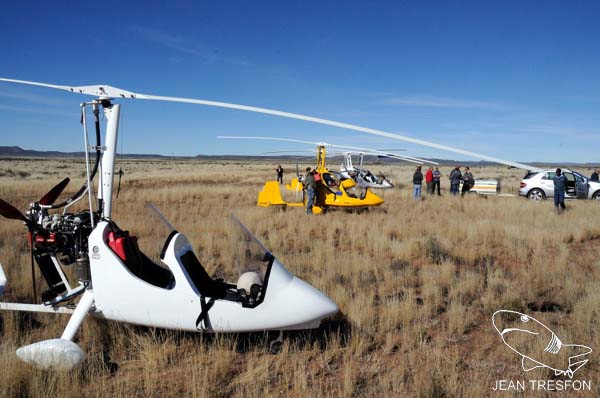
Parked in the thorn beds at Richmond... Lots of flat tyres!
Our first landing was at Richmond on what turned out to be a little used and overgrown strip. I was nervous as this was the smallest and most intimidating place that I had tried to land on to date and the touchdown point had 9 other gyros parked right there with a full compliment of spectators (including one of my instructors!), but luckily I pulled off a very neat landing. But then I climbed out to find that we had all landed on a giant bed of duiwel dorings. One of the gyros from the other group was sitting with both back wheels flat in a matter of minutes and my wheels looked like porcupines with all the thorns sprouting out. Dave suggested that we don’t hang about and take off immediately after refueling. We made it safely out and routed for Gariep after what was definitely the most intense take off of my short flying career. Len’s group were much delayed, having to taxi onto a nearby tar road, take a trip into town for tyre services, refit the tyres and take off from the road courtesy of a friendly traffic officer.

First sight of Gariep Dam.

Gariep Dam is full to capacity.

Gariep Dam is full to capacity.

Gariep Dam is full to capacity.

Gariep Dam is full to capacity.

Arriving at Gariep Airfield and even being allocated hangar space!
Finally the Gariep Dam wall hove into view and we ended up having to circle over the dam for a few minutes due to all the gyro traffic landing at the airfield. Our turn arrived and we touched at Gariep with some apprehension (thinking we might well be landing with one or more flat tyres). I noticed that my usually very accurate Optifuel unit said I had 38lt fuel remaining but when I checked the tank there was only 30lt left. My tired brain did not pick up on this discrepancy and insist on investigating further. We pushed the gyros into the hangar and within about 10 minutes both of Dave’s back tyres were flat. Generously assisted by Butch Brown, Dave got both tyres sorted and then it was off to the resort for a great dinner and more than a few drinks.
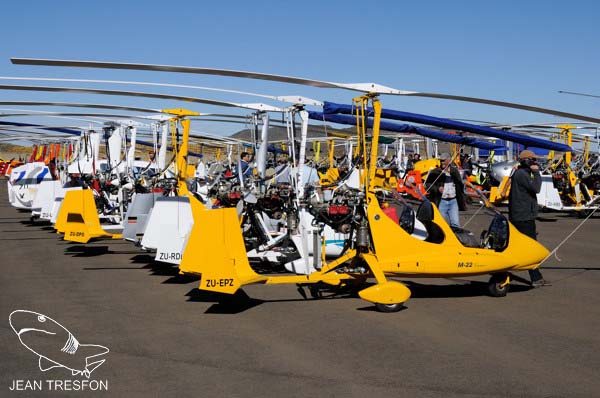
66 Gyros managed to be present for the record photo!

66 Gyros managed to be present for the record photo!

66 Gyros managed to be present for the record photo!
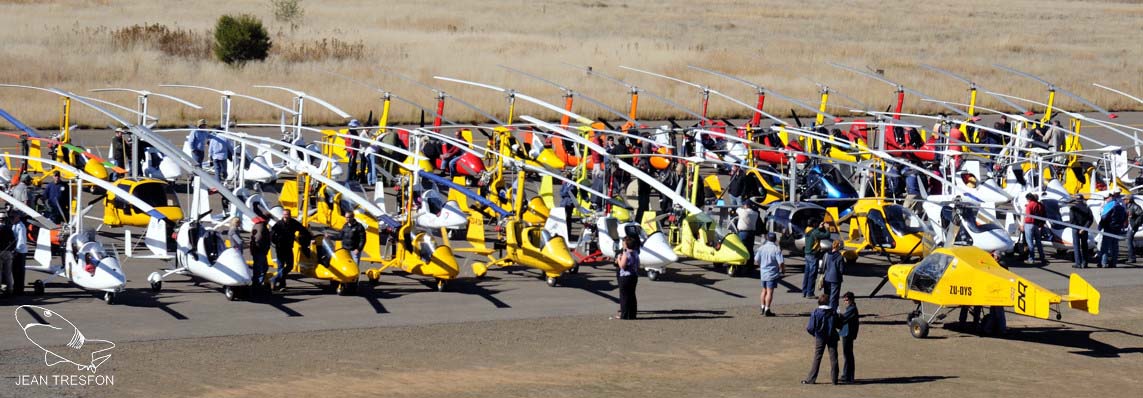
66 Gyros managed to be present for the record photo!
Nursing a sore head on the Saturday morning we applied the standard cure of a full breakfast and then caught a lift to the airfield. At about 9am all the gyros were hauled out of the hangar and lined up for a photo shoot. Seeing all the gyros together was a hugely impressive sight. Most of the pilots took the opportunity to admire the other gyros and chat to the other pilots. A total of 66 gyros were present for the photo, which is indeed a new world record. A few folks then went off to spend the morning flying (what else???). Around mid-day we decided to fly back to Colesburg and check out Dave’s extended family’s farm.

Colesburg Koppie in the late afternoon sun light. Legend has it that the British drag big field guns to the top once upon a time...

Colesburg.
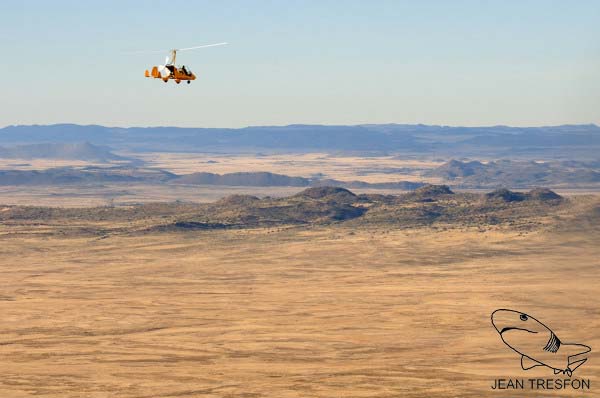
Dave returns to Gariep in the evening light.
During my preflight I noticed a very dirty engine and propeller covered in a fuel residue. I called Dave over and we started a fault finding inspection. Eventually we found the leak where the missing fuel had escaped! (Another big lesson to pay attention to the small voice of your aerie when she tries to tell you something). Hose clamps were tightened and I spent some time running up the engine on the ground and with no further fuel leakage. We then took off and flew to Colesburg for a magic evening flight, landing at the strip at Hunter’s Moon to check the fuel (all good) and then back to Gariep.
That evening was the main function and since most people reading this would have been there I will not go into any detail. It will suffice to say that it was a superb evening. A huge thank you is due to Paul Roux for all his hard work and I was hugely impressed with the spirit of the gyro community, particularly when almost R17k was raised for a gyro pilot in hospital recovering from serious burns. My fellow group member Dave Lehr was suitably surprised to win the Airman of the year trophy and was uncharacteristically at a loss for words. And all I can say regarding the entertainment is Grumpy Rocks! I was also very impressed (especially as a new pilot) by the enthusiasm and impetus provided by two of the more experienced pilots, Len Klopper and Johan Stemmet. Both of them have flown for many years and yet are just as excited about the sport as a new pilot approaching it for the first time, if not more so.
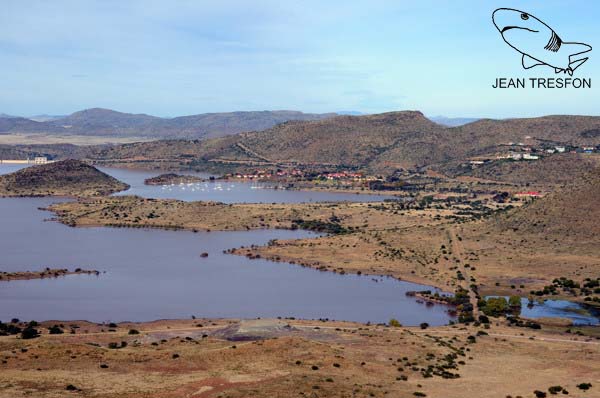
Leaving Gariep past the resort and yacht basin.

The river is full and is looks stunning as we head west.
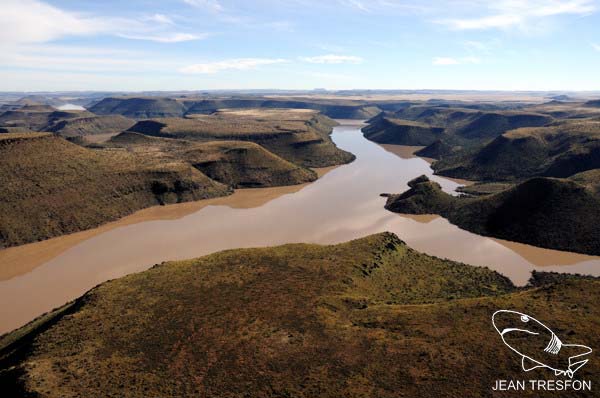
The river is full and is looks stunning as we head west.

The Vanderkloof Dam is also full with millions of litres passing through the sluice gates.

The Vanderkloof Dam is also full with millions of litres passing through the sluice gates.

Jonathan routes low level along the river.

The irrigated crop circles as we line up for final approach into Douglas for refueling.

The last 20km before Upington is stunning grasslands.
Anyway enough of that and back to the flying. Sunday morning saw us take to the air again after a delay in refueling. Most of the other pilots were head back to either Cape Town or Gauteng and we headed off on our first leg of the Orange River Odyssey. Prior to leaving some very experienced pilots such as Mark Bellingham had taken me aside and warned me about the dangers of low flying along the river due to the numerous wires and power lines slung across the crags. I am constantly amazed by how much the more experienced pilots are willing to share if you have the right attitude and are willing to listen. With Mark’s advice fresh in my mind I flew above the cliffs and gorges as the river thundered along below. All the dams we passed were full to capacity and had water bursting from the sluice gates. We passed Orania and then landed a beautiful strip at Douglas to refuel. Dave and Jonathan had arranged for a bowser of avgas to be towed to the strip and on a Sunday nogal! The chap who organized the fuel for us told us he had had a snoek braai the night before…In Douglas!!! After a sandwich from my lunch pack (another legacy of Gariep Forever Resorts) we took off again and headed for Prieska. Along this section the landscape surrounding the river is largely flat. A few miles out from Prieska my bum had become bad friends with my gyro seat and I asked if we could do a refueling stop. We also had quite a serious headwind and it would be a chance to inspect the tanks. The landing and refueling was uneventful and we were soon airborne again and routing for Grobblersdaal. The headwind become fairly strong and the fuel levels dropped accordingly. We decided to land at a small strip at Grobblersdaal and being in the lead I descended to do a runway inspection. There was a bakkie, several people and some horses parked in the middle of the runway and I had to complete 3 low level passes before they understood that we actually intended to use the runway! We landed, checked the tanks, recalculated the fuel burn rates and groundspeeds adjusted for the headwind and were happy that we could make it to Uppington. We changed the plan slightly and decided to route direct and not follow the river for this last little stretch. The next hour was some of the most stunning flying I have done as we routed low level through beautiful grasslands and then were routed in by Uppington Approach Control.
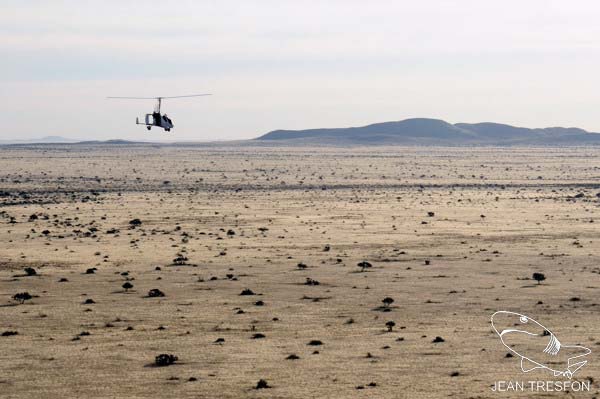
The last 20km before Upington is stunning grasslands.
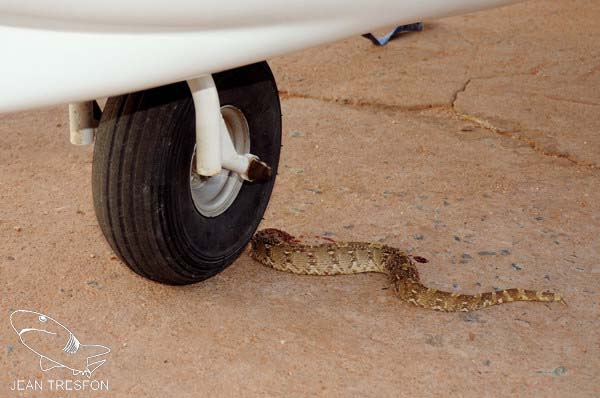
Those Upington lads are tough... they pave the runways with
After all the rough little dirt strips I was thrown a little by the massive tar runway at Uppington but soon got used to the tar again. Taxing into the small craft hangars we were welcomed by Eben Mocke junior with a few beers. After about 6.5 hours in the air the beer went down like a homesick mole. Eben had just dispatched a

Jonathan admires the camel outside the Upington Police Station.

Eben Mocke shows me the RAF2000... clearly a very capable gyro.
A more generous and welcoming bunch of people you will not find. We were driven to the Mocke family guesthouse and given the use of a bakkie. Eben and Eben engaged Dave and Jonathan in a technical discussion about the merits of the RAF and what was immediately apparent was that these folks are hugely technically proficient and sell the benefits of their machines by extolling their technical virtues and strengths without ever feeling the need to run down products made by other manufacturers. Following a quick trip into town to eat a small cow we returned and hit the sack. Early on Monday morning we packed and took the bakkie to the airfield to start the refueling process. However before we could begin Eben and his dad insisted on taking each of us up in an RAF for a demonstration. I am too new a pilot to fully appreciate the complexities and handling of the RAF as I have no real basis for comparison but was impressed by the smooth power from the Subaru engine and the complete lack of any stick shake. Eben took the time to explain how their “Stabilator” works and I was well impressed with his quiet confidence and flying ability. This is exactly the type of person I would want as an instructor. Dave and Jonathan were also well impressed by the RAFs and commented that they were very light on the stick, very maneuverable and a lot more stable than they were expecting. We also had a quick tour of the factory facilities and it is amazing to see how just about everything is down “in-house”. It was with a touch of sadness that we left Upington, having stayed there only one night but already having been made to feel part of the Mocke family.

Farms line the river banks as we depart Upington.

Dave routes low level along the river.

The private strip at Dundi Lodge. A stunning place and well worth a visit in its own right.

The private strip at Dundi Lodge. A stunning place and well worth a visit in its own right.

The Augrabies Falls is awesome with so much water passing through. We were careful to stay 1500ft AGL over the reserve.

The Augrabies Falls is awesome with so much water passing through. We were careful to stay 1500ft AGL over the reserve.

Nothing but mountains as far as the eye can see... and then suddenly a huge farm right alongside the river bed.

Nothing but mountains as far as the eye can see... and then suddenly a huge farm right alongside the river bed.

45 million people in SA and nary a soul to be seen... wonderful!

Jonathan enjoying some low level flying along the river, ever mindful of wires.
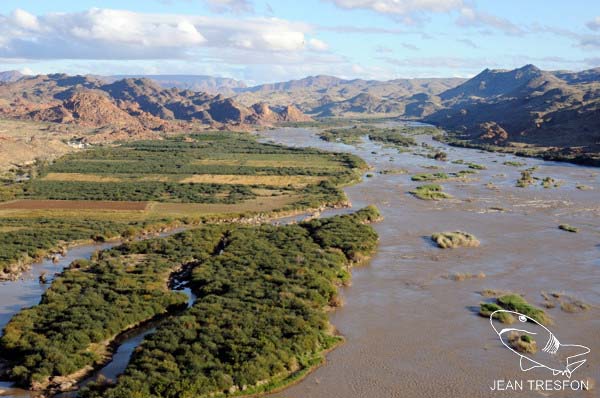
Almost at Klein Pella.

Turning left and climbing up a valley before arriving at Klein Pella.

Is that a Gyro or a 4x4? Quite a long taxi to the fuel pump.
That day’s flying from Upington to Klein Pella has to be the best day’s flying I have ever done (admittedly not difficult coming off a low experience base but still…) We routed along the river and decided to land at the Dundi Lodge strip to transfer the fuel from the jerry cans. On landing we met the lodge owner and stopped for a chat. This looks to be a place that is a destination in its own right. The lodge is right on the strip and looks to be first class. I did not get to see in the lodge itself, only the bathroom which the owner kindly let us use. I am a firm believer that you can tell a lot about a place by its bathrooms and I’ll tell you now that I’ll be going back to stay at Dundi. After taking off again we immediately climbed to 1500ft AGL, mindful of the fact that we were entering the Augrabies National Park. After circling the falls a few times to take pictures we routed along the river again and over some of the most dramatic scenery I have ever seen. Red rocks, brown water, green fields, blue skies and it just went on and on… Flying low along the river, mindful of wires, we were hit by a total sensory overload of magnificent vistas. At last we exited the canyons and flew up a small valley to land at the Klein Pella Resort. A long taxi down to the resort followed and we parked the gyros under their covers, and went in search of a few beers and some dinner. Following a great meal we went to bed early and woke up to a forecast of a few showers and some wind.

Taking off the next morning the weather was a bit dubious.

Flying next to the mountains can feel quite threatening, no where to go on the left side...

Flying next to the mountains can feel quite threatening, no where to go on the left side...
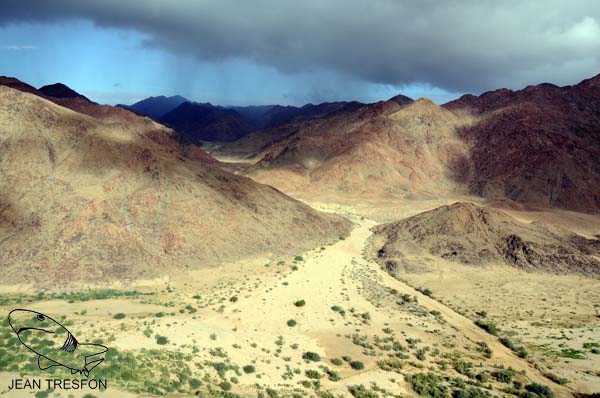
Suddenly the rain starts along the mountain tops.

Not much place to turn to avoid the weather.

Approaching the main border post just before Noordoewer as the N7 becomes the B1.
Tuesday morning started with a great breakfast, and Dave casually dropped into the conversation that Sendlingsdrift (our next overnight stop) might be self-catering. Obviously this posed a problem as we had no food, so we asked the manageress at Klein Pella to make us up some dinner packs with some chops and wors etc. After collecting the food and loading our bags we taxied down to the fuel station, filled up and then taxied about 2kms to the strip. The weather looked fairly clear and we pre-flighted, warmed up and took off. The sky was overcast and the mood somewhat different from our arrival the night before. There was a bit of wind and the ride was a bit bumpy from time to time. After a while we passed the main border crossing (N1 to B1) just before Noordoewer and then spotted rain ahead. On the left side were big mountains, on the right was forbidden airspace and ahead was light rain. We flew through the rain and the rotors started whistling. Dave advised me to keep an eye on the rotor RPM and load the rotors if I saw it dropping. The wind knocked us about a bit and then we made the call to cut out a section of river and follow a road on the “wrong” side of the river to avoid heavier rain showers. Eventually we approached the first of our available precautionary landing strips at Grassdrif and decided to put down and wait out the rain showers. It was a fairly tricky strong crosswind landing and after we were all safely down we quickly covered the gyros and then looked for shelter.

On the wrong side of the river... Not much help here if we have to put down.
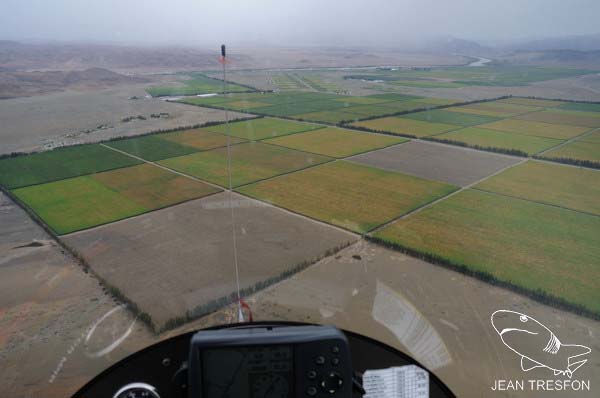
Heading for a precautionary landing at Grassdrif as the rain really starts to fall.

Not much here to survive on!
When I say there was nothing at Grassdrif I mean NOTHING! A hundred metres away we spotted an old rusted hulk of an abandoned steamroller and decided to use it for shelter. After a while an emaciated mongrel dog sauntered up and joined our group. I was sitting and thinking about how unpleasant having to spend the night here with no sleeping bags might be, when Jonathan said, “Oh well we can always sleep under the steam roller and eat the dog if we have to!” I think the dog was having similar thoughts about us…
After a few hours the weather showed a slight improvement and we took off again.
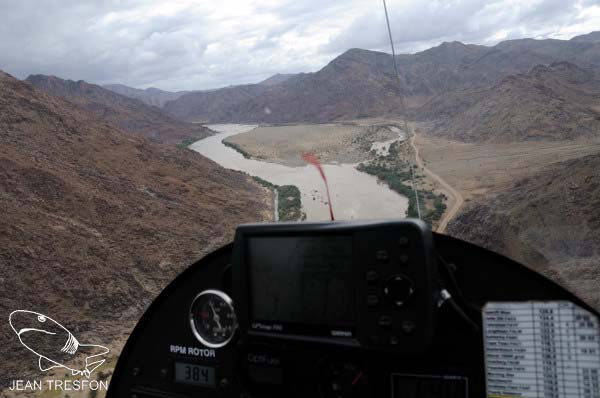
After an hour or two we head off again... no photos for the last 1/2 hour as we fought our gyros to Sendlingsdrift.
Shortly thereafter it turned for the worse and the rain closed in front and behind us. The wind started to get nasty and I was quietly crapping myself. We were now flying through the Richterveld and the low cloud base limited our altitude while landing options were limited to a 4x4 track along the riverbed. Every now and again a gust would knock my gyro almost 90 degrees off course. More often than not his was followed by a downdraft that required full power to arrest with not much altitude to spare. Then the nose would be thrown up. This was probably the longest 15 minutes of my life as I fought my gyro towards Sendlingsdrift. I was way out of my comfort zone and kept thinking that I should be on the ground when at last the strip at Sendlingsdrift appeared. Fighting us to the end we encountered a gusty crosswind landing and then we were down. Not to be beaten easily the weather gods then decided we needed more punishment and it rained steadily as we taxied a few km from the strip to the fuel station. Bedraggled, tired, scared witless and boy did I need a drink… Oh didn’t we know said a person we met on in the village, the only bar is closed on a Tuesday!!! We refueled and covered the gyros. The rain stopped for a moment and I discovered I had a flat rear tyre and spent the next hour fixing the puncture with help from Dave and Jonathan. (NB. If you fly a Magni make sure you have a 24 spanner and some Allen keys in your tool bag!) At last we trudged into our accommodation, made a fire and cooked the chops from Klein Pella. We had found a small shop and managed to buy a tin of beans, sweet corn and tuna as well as a loaf of bread. Dinner that night was chops, beans and sweet corn, while breakfast the next morning was bread and tuna.
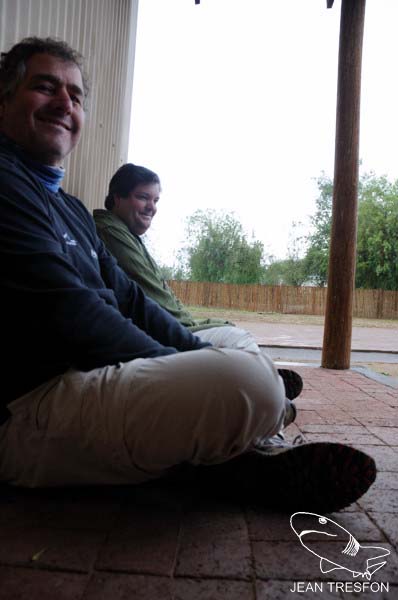
Waiting for the rain to stop... rain rain go away, come back another day!

The last 50km of the Orange River is lined with diamond mines.

Overflying Alexander Bay, no longer a manned airfield.

The Orange River empties into the sea at Alexander Bay.
Wednesday morning we woke to pouring rain and were obviously not going anywhere. I was determined not to have a repeat performance from the previous day and we waited and waited for the rain to stop. I had learned my lesson about flying in bad weather. After an hour or two the tail of the front passed over and we were treated to blue skies and scattered clouds. We taxied all the way back to the strip, pre-flight checks done and off we went. The first 50km was mostly riverside diamond mines and after 80km Alexander Bay appeared. From there we routed low level coastwise to Kleinzee, having obtained prior permission to land in the diamond area for refueling. A local pilot, Rodney, assisted us with fuel and sorting out the logistics and after a chat to this super helpful guy we were on our way again. For km and km there was nothing but barren rocky coastline strewn with the debris of marine diamond mining. Hoses, pumps, gravel piles and old caravans littered the coast. We landed again shortly afterwards at the small strip at Hondeklip Baai to top up the tanks and then carried on to the south.

Diamond boats shelter in the "harbour" as the wild seas crash onto the rocks.

Large dumps of processed gravel lie alongside the coast.
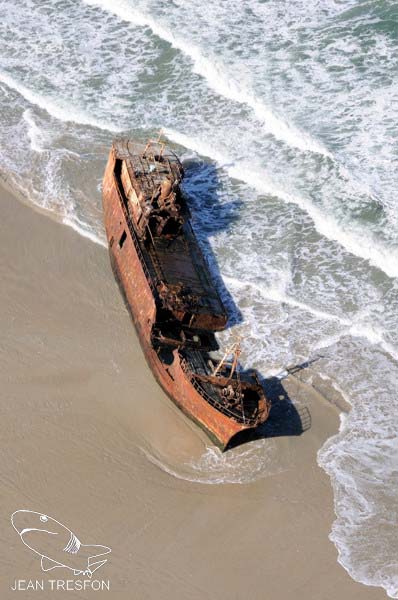
The skeletons of dead ships litter the coastline... this is an unforgiving place.

Approaching Kleinzee, a diamond mining town.
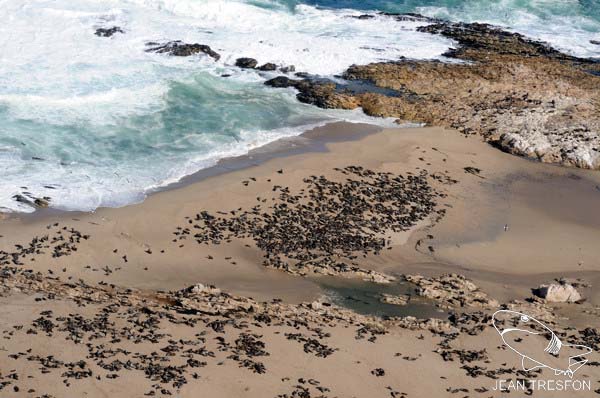
A large seal colony is situated just before Kleinzee.

This refueling stop had to be pre-authorised. Unannounced landings in the diamond area do not end well!
The SE wind started to blow strongly giving us yet another headwind. Time started to run short and we realized we would not make Cape Town that night. Approaching Strandfontein we turned up into the Olifants River mouth and routed for Vredendaal via Lutzville. Jonathan’s original instructor Dirk stayed there and Jonathan was sure he could help us out with transport and a place to stay. Landing at Vredendaal in the icy evening wind we found out that Dirk and company had not yet made it back from Gariep! They had been trapped by rain in Prince Albert and were still there several days later. We pushed on to Lamberts Bay and were met by Avril Mocke (brother of Eben Mocke) and his friend Gerhard. Typical of the Mocke hospitality we had previously experienced, Avril did not disappoint. Gerhard owned a guesthouse (Skipper se Huis) as well as the best restaurant (Isabella’s) in town and not only did we get to experience both, but Gerhard gave us his bakkie for the night as well. After the self-catering experience of the previous night we ate up a storm and retired to bed well contented.

The skeletons of dead ships litter the coastline... this is an unforgiving place.
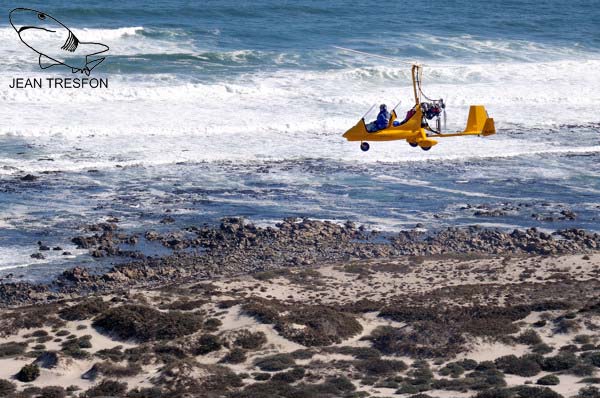
Dave enjoys some low level touring in his new baby.

Dave enjoys some low level touring in his new baby.

Dave enjoys some low level touring in his new baby.

Hondeklip Baai.

Chasing my shadow down the beach...
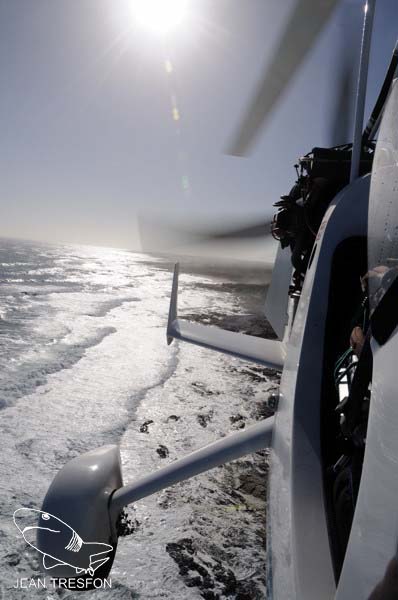
The sun starts to descend as we run out of time to make it all the way back to Cape Town.
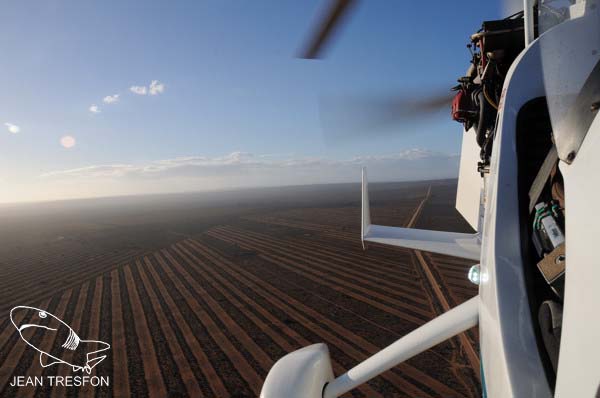
Alas Dirk was not there and we had to take off again and fly to Lamberts Bay.

A late evening landing at Lamberts Bay. Note the windsock in the stiff SE.
Thursday morning saw us meet Gerhard and Avril at the fuel station where they had brought us a collection of assorted jerry cans to ferry fuel back to the gyros. After refueling and saying our goodbyes we took of and routed around Baboon Point at Elands Bay and then low level along the beach to Dwarskersbos. I could actually feel the stick start to shake a little as the salt build up on the rotor blades increased. Dave checked in with the ATC at Langebaan and we were cleared for a coastwise routing along St. Helena Bay, Shelley Point, Britannia Bay, Paternoster, Tittiesbaai and then down to Jacobsbaai. This piece of coastline is stunningly beautiful and has a hugely interesting marine history with over 38 shipwrecks along this stretch alone. At Jacobsbaai we turned inland and landed at Saldahna Vredenburg Airfield for a final refueling. From there we stayed inland and routed directly for the Darling wind farm and then on to Goedverwacht. Contrary to my previous feelings the strip at Goedverwacht now looked massive and landing there was a totally relaxed affair. It was 7 days later, 34 hours flying time and around 2800km travelled. I learnt almost as much in this week as during my entire training course.

The prop from the Sybille. Confiscated from illegal salvors and on display at the museum.
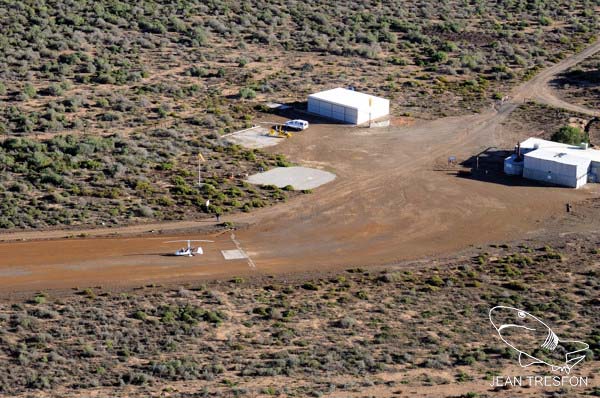
Dave and Jonathan line up for take off from Lamberts Bay strip.

Lamberts Bay.
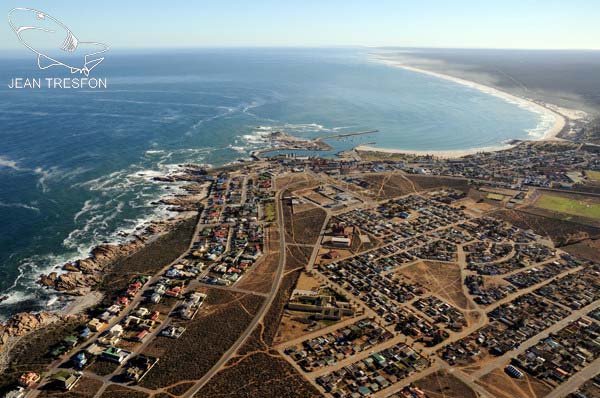
Lamberts Bay.

Low level from Baboon Point to Dwarskersbos... pure exhilaration!

A large comorant colony on the neach.

St Helena Bay.

Dave flies over Brittania Bay.

Cape Columbine lighthouse and Tittiesbaai.

Cape Columbine lighthouse and Tittiesbaai.
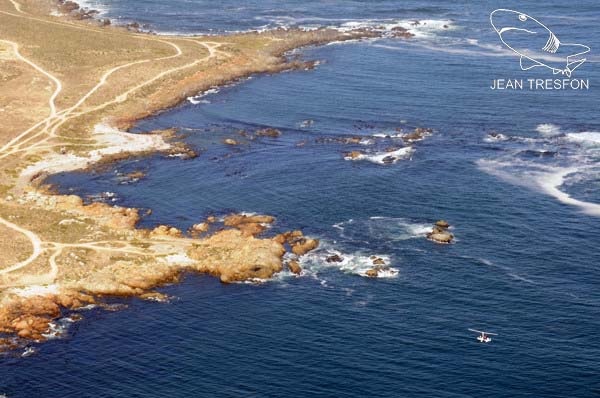
Jonathan approaches Trekoskraal from the sea.

Jacobsbaai.

The Darling wind generators.

Back home at Goedverwacht.
It being late we quickly parked the gyros in the hanger and hurried home to our respective families (Dave and I both have young kids). The following day (Friday) I returned with the intention of giving my gyro a good wash, but it was such a beautiful day that I did a quick flight. Around the peninsula. For about 2 hours. It’s catching, this flying thing!
For a full set of photos please visit: http://www.flickr.com/photos/jtresfon/s ... 729672411/
Regards
Jean Tresfon
29.5.2011









